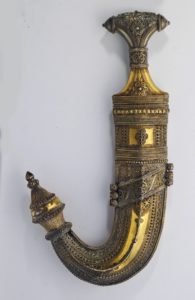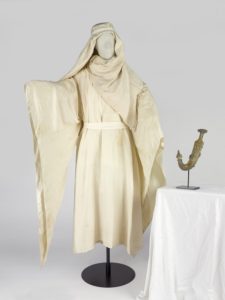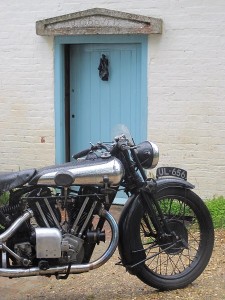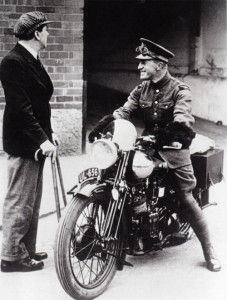- National Army Museum saves Lawrence’s dagger for the nation
- Clouds Hill homecoming for Lawrence’s iconic Brough Superior motorcycle
- On the anniversary of Lawrence’s fatal accident, Society calls for rethink on quarrying near Moreton cemetery
- Government extends export bar on Lawrence’s dagger amid hopes UK buyer can be found
- Society invited to present Moreton quarry objections to Dorset County Council
- Bullet ‘vindicates Lawrence’s account of Arab Revolt’
- Theeb flies the flag for Jordan at the Oscars and Baftas
- Government halts export of Lawrence’s ‘iconic’
dagger and robes - Society applies for Listed status for 2 Polstead Road
National Army Museum saves Lawrence’s dagger
for the nation
18 October 2016: Lawrence’s ornately decorated silver-gilt dagger – one of three worn by him during the two years of the Arab Revolt, and later left with Lady Kathleen Scott after she sculpted him in 1921 – has been saved for the nation, after the National Army
Museum stepped in to prevent it being sold abroad.
Lawrence’s first dagger, given to him by Sherif Abdullah, was in turn presented as a gift to the Howeitat chiefs, and has presumably disappeared forever. A gold dagger made specially for him in Mecca was sold to Lionel Curtis for £125 to fund repairs to his cottage, Clouds Hill, and is now in the collection of All Souls College, Oxford.
The silver-gilt dagger was presented to Lawrence by Sherif Nasir to celebrate the taking of Akaba in July 1917. After he was sculpted by Lady Scott in February 1921 wearing the dagger and a set of his
Arabian robes, he left them in her care while he attended the Cairo conference. Though there is evidence in his letters that he later
regretted their loss, they remained with Lady Scott’s family until last year, when they were put up for auction at Christie’s in London. The
dagger and robes were sold to overseas buyers for £122,500 and £12,500 respectively. The Government then put an export bar on both items, to give an opportunity for buyers to match the price and keep them in the UK.
The National Army Museum has now secured the dagger for the
nation with a £78,400 grant from the National Heritage Memorial Fund. The Society has heard privately that the buyer of the robes has withdrawn the export licence application and will keep them in the UK, while expressing willingness to lend them to appropriate
institutions.
A further £35,000 grant from the National Heritage Memorial Fund has enabled the National Army Museum to buy an ivory silk robe and silk headdress belonging to Lawrence which were auctioned in Christie’s Out of the Ordinary Sale in London in September.
The robe was one of two given by Lawrence to the mother of his Tank Corps friend Arthur Russell, with instructions to cut them up to make dresses. Luckily, this one was saved from the scissors. It was bought for £27,500 in the sale. The silk headdress, given to the artist Cosmo Clark when he depicted Lawrence in 1922, was bought for £8,125.
Two other pieces of Lawrence’s Arabian clothing, sold separately to other buyers in the Out of the Ordinary Sale, were a headscarf
woven from red silk and gold thread, given by Lawrence to Janet Laurie, which sold for £10,000. A purple silk and copper agal which Lawrence presented to Clare Sydney-Smith, wife of his commanding officer at RAF Cattewater in Plymouth, fetched £27,500.
Announcing the purchase of the dagger, robes and headdress for the nation, the National Army Museum drew attention to the immense cultural impact that Lawrence has had in the century since his wartime achievements.
Museum spokesman Dr Peter Johnston said: “What makes the dagger and robes so significant, and such an important part of British heritage, is the way in which they have featured in the cultural memory and legacy of Lawrence and the Middle East campaign of the First World War.”
The dagger and robes will go on show at the museum, in Royal Hospital Road, Chelsea, when it reopens after a major refurbishment next year. To see the full press release, click HERE.
——————————————————
Clouds Hill homecoming for Lawrence’s iconic
Brough Superior motorcycle
21 May 2016: UL 656 – Lawrence’s penultimate Brough Superior motorcycle, known affectionately as George VI – made its first public appearance for around 50 years, when it returned to Clouds Hill cottage as part of the National Trust’s annual Lawrence Week.
The 1929 SS100 motorcycle, on which Lawrence posed in the iconic photograph with George Brough, and on which Lady Nancy Astor rode pillion, has recently undergone a restoration by a master
restorer.
Lawrence bought the motorcycle after returning to the UK from his RAF posting in India in 1929, and owned it until 1932.
It appeared at Lawrence Week as part of a rally of Brough Superior motorcycles organised by Alan Payne, of the T. E. Lawrence Society and Brough Superior Club, and Bob Burden, of the Brough Superior Club.
For more news on the Lawrence Week events, see HERE.
——————————————————
On the anniversary of Lawrence’s fatal accident, Society calls for rethink on quarrying near Moreton cemetery
13 May 2016: Vocal opponents to a proposed quarry site near Lawrence’s grave in Moreton rallied at a meeting of the Bournemouth, Dorset and Poole Minerals and Waste Policy Joint Advisory Committee at Dorset County Hall,
T. E. Lawrence Society vice-chair Alan Payne told the committee: “It was at 11.30am on May 13, 81 years ago, that T. E. Lawrence had his fatal accident and it would be a fitting day for members of this committee to re-consider the proposed designation.”
For more about the meeting, see the Dorset Echo’s coverage HERE.
——————————————————
Government extends export ban on Lawrence’s dagger amid hopes that UK buyer can be found
3 May 2016: A temporary export bar placed on Lawrence’s silver-gilt dagger and robes, after they were bought at auction by a foreign buyer, has been extended to 1 July.
The Arts Council, which administers temporary export bans on items of cultural significance, said serious expressions of interest have been received. A new buyer will have to match the auction price of £122,500 for the dagger and £12,500 for the robes.
For more, see the coverage in The Independent HERE.
——————————————————
Society invited to present Moreton quarry objections to Dorset County Council
29 April 2016: After the Society submitted an objection last year to Dorset County Council’s draft proposals for a sand and gravel quarry half a mile from Moreton village, we have now been invited to present our views to the Bournemouth, Dorset and Poole Minerals and Waste Policy Joint Advisory Committee in May.
Society vice-chair Alan Payne – a planning consultant who wrote the Society’s response to the quarry consultation – will be attending to speak on behalf of the Society and to present an online petition, “Let Lawrence of Arabia Rest in Peace”, which was signed by nearly 450 people from around the world.
The Society believes that the quarry proposal will have a disastrous impact on the tranquil surroundings of the village of Moreton and the cemetery where Lawrence lies.
We will keep members updated on how the consultation progresses.
Dorset County Council’s proposals can be viewed at http://consult.dorsetforyou.com/portal/draft_minerals_plan…. Go to Appendix A: Site Allocations, then scroll to Site AS-25. Two submissions by the Society can be found on page 5 of the responses to the consultation.
——————————————————
Bullet ‘vindicates Lawrence’s account of Arab Revolt’
31 March 2016: A bullet discovered in the Arabian desert by a team of archaeologists working as part of the Great Arab Revolt Project has appeared to confirm that Lawrence’s account of the revolt in Seven Pillars of Wisdom is largely accurate.
Announcing the finding of the bullet at the site of the 1917 train
ambush at Hallat Ammar, project director Dr Neil Faulkner of the University of Bristol told the press today: “Lawrence has something of a reputation as a teller of tall tales, but this bullet – and the other archaeological evidence we unearthed during ten years of fieldwork – indicates how reliable his account of the Arab Revolt in Seven Pillars of Wisdom is.”
Professor Nicholas Saunders of the University of Bristol added: “The bullet we found came from a Colt automatic pistol, the type of gun known to be carried by Lawrence and almost certainly not used by any of the ambush’s other participants.”
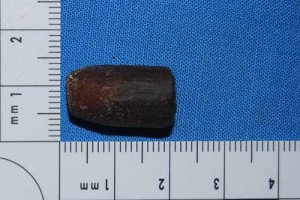 The bullet discovered by archaeologists from the
The bullet discovered by archaeologists from the
Great Arab Revolt Project. Image credit © Ali Baldry
While several of Lawrence’s biographers have accused him of embellishing his stories, nothing the archaeologists found at any of the sites they excavated supports this view.
GARP excavated dozens of sites across the Arabian desert associated with the 1916-1918 Arab Revolt.
Professor Saunders said: “It is extraordinary that after 100 years new discoveries like this are still being made, casting new light on a guerrilla war which helped reshape the Middle East after 1918 – the consequences of which we are still living with today.”
Dr Neil Faulkner’s book Lawrence of Arabia’s War was published by Yale University Press on April 21.
——————————————————
Theeb flies the flag for Jordan at the Oscars and Baftas
28 February 2016: Theeb – Naji Abu Nowar’s film set during the early days of the Arab Revolt – has become the first Jordanian film ever to be nominated for an Oscar. Though it lost out on the night to Hungarian film Son of Saul in the Best Foreign Language Film category, the Oscar nomination capped a hugely successful year for the film, including a Bafta for writer/director Naji Abu Nowar and producer Rupert Lloyd in the Outstanding Debut category, and the Orizzonti Award for Best Director for Naji Abu Nowar at the Venice Film Festival.
The film, telling the story of a Bedouin boy’s coming-of-age, when he embarks on a treacherous journey with a mysterious British Army officer, was shot entirely in Jordan using local Bedouin tribespeople.
——————————————————
Government halts export of Lawrence’s ‘iconic’
dagger and robes
2 February 2016: The Department for Culture Media and Sport has placed an embargo on the export of Lawrence’s silver-gilt dagger and robes which were auctioned at Christie’s in London last year.
In a press release it announced:
UK RISKS LOSING LAWRENCE OF ARABIA’S ICONIC ROBES
AND DAGGER
Two of T.E. Lawrence’s most iconic possessions are at risk of being exported from the UK unless a buyer can be found to match the asking prices of £122,500 for his dagger and £12,500 for his robes.
Culture Minister Ed Vaizey has placed two separate temporary export bars to provide an opportunity to keep these national treasures in the UK.
Lawrence was considered one of the most recognisable figures of the First World War, following his work in the Middle East and his involvement in the Arab Revolt.
The archaeologist and diplomat worked closely with numerous Arab leaders and would always be seen in traditional Arab dress. These white silk robes were made in Mecca or Medina and he wears them in the 1919 oil portrait by Augustus John.
The steel and silver dagger was famously presented to him by Sherif Nasir in 1917 after the victory at Aqaba in Jordan, a scene featured in the
Oscar-winning film Lawrence of Arabia.
Lawrence posed with both the curved dagger – called a jambiya – and the robes while sitting for the sculptor Lady Kathleen Scott, the widow of Scott of the Antarctic, in 1921. He left them behind after his final session so Scott could continue working and they have remained in her family ever since.
Culture Minister Ed Vaizey said:
“T.E. Lawrence was one of the most extraordinary figures of the 20th Century. These robes and dagger are absolutely iconic and a key part of his enduring image. It is important that these classic objects remain in the UK.”
The decision to defer the export licences follows a recommendation by the Reviewing Committee on the Export of Works of Art and Objects of Cultural Interest (RCEWA), administered by Arts Council England.
The RCEWA made their recommendation on the grounds of both the robes and dagger’s close association with our history and national life.
RCEWA Chairman Sir Hayden Phillips said:
“Although the depiction, in the film Lawrence of Arabia, of Lawrence leading a sweeping camel charge across the desert into Aqaba in 1917 is probably a romantic exaggeration – stunning though it is – the taking of Aqaba from the landward side, with the help of Auda Abu Tayi, leader of the northern Howeitat, was an extraordinary feat and marked a crucial turning point in the campaign. The dagger was presented to Lawrence by Sherif Nasir in gratitude for Lawrence’s leadership and as a spontaneous mark of respect. The robes and dagger together form a crucial part of the images of Lawrence in painting, sculpture and photographs; and they are therefore an integral part of his life and our history.”
The decision on the export licence application for the robes will be
deferred until 1 April 2016. This may be extended until 1 July 2016 if a serious intention to raise funds to purchase the robes is made at the recommended price of £12,500 (plus VAT of £500).
The decision on the export licence application for the dagger will be
deferred until 1 April 2016. This may be extended until 1 July 2016 if a serious intention to raise funds to purchase the robes is made at the recommended price of £122,500 (plus VAT of £4,500).
——————————————————
Society applies for Listed status for 2 Polstead Road
1 January 2016: The T. E. Lawrence Society has submitted a formal application to Historic England to list Lawrence’s childhood home at 2 Polstead Road, Oxford, as a Building of Special Architectural or Historic Interest.
Working with Councillor Liz Wade of Oxford City Council, the Society was fortunate to be able to draw on support from around the world to put together documentary evidence to back its application, including photographs by members who have visited the house, and an architectural assessment by Robert Franklin of All Souls College.
Apart from emphasising the historic importance of the house,
together with the bungalow built in the back garden for the youthful T. E. Lawrence, the Society’s application points out that 2 Polstead Road must be considered essentially to be a “building at risk”, having been empty for some time since the death of the previous occupant.
The Society will keep members informed on how the application progresses.
